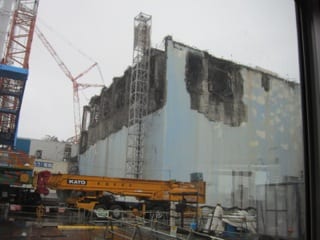Risk and resilience in Japan after the Fukushima disaster
By Oli Usher, on 22 November 2013
There is no amount of concrete that could have kept people safe from the 2011 Japanese tsunami – and in any case, the height of the wave could never have been predicted. But learning the right lessons from past disasters, along with a helping hand from technology, could help keep us safer in the future.
That was the message delivered by Prof Peter Sammonds (UCL Institute of Risk & Disaster Reduction) in Tuesday’s Lunch Hour Lecture.
Japan is, in many ways, an ideal place to learn from in the field of natural disasters. A prosperous, well-governed and highly educated nation, it also has a long history of dealing with natural hazards, particularly earthquakes and tsunamis. The successes and failures of disaster management in Japan over the past century offer a rich vein of data for researchers like him to mine.
The key lesson, he argued, is to understand the complexity of disasters and how one calamitous event can cascade in fundamentally unpredictable ways.
The Kanto earthquake that hit Tokyo in 1923 offers a particularly vivid historical account of how natural and human factors combined in unpredictable ways. The earthquake triggered a tsunami, a cyclone struck the disaster area, and fires and landslides swept through the wreckage.
On top of this, many died at human hands, in mob killings of ethnic Koreans accused of benefiting from the disaster and summary executions of political dissidents by the police and army. When the dust settled, 100,000 were dead and more than three million lost their homes.
Lest this 90-year-old disaster seem too remote to teach us much today, more recent disasters follow similarly complex paths. And in today’s disasters, Sammonds explained, there is the added complication of scientific theories that try, and do not always succeed, in predicting and preventing them.
The Kobe earthquake of 1995 is a case in point. The consensus among geologists who studied the tension in Japan’s tectonic plates, was that the next big quake would hit the east of the country, near Tokyo. Government and civil society concentrated their efforts there – but instead of hitting Tokyo, the 1995 quake hit the western city of Kobe, where even basic precautions like stockpiling bottled water and torches had not been taken by the general public. This failed prediction struck a major blow to earthquake prediction around the world, with funds cut and programmes suspended.
Which, Sammonds says, brings us to Fukushima. The outline of the disaster is still fresh in people’s minds: a powerful earthquake, followed by a tsunami which wiped out the Fukushima Daiichi nuclear power plant. (The 20,000 people killed in the disaster don’t get as much attention.)
The conventional wisdom says that this was all more or less predictable – the fundamental problem was the sea wall around the power plant being too low to stop tsunami in a known earthquake zone.
Not so fast, Sammonds argues. Before we even begin talking about human-influenced factors like the siting of the plant and the construction of flood defences, we should pause to consider the understanding of the region’s geology when the plant was built.
Since Fukushima Daiichi was built, the interpretation of its tectonic setting has changed. When the earthquake struck, it was far stronger and involved more sections of the fault line than any theory had predicted.
And scientists only managed last year – a year after the Fukushima disaster – to satisfactorily explain how the tsunami could be as high as the wave that hit the power plant. On top of all this, it wasn’t the earthquake or even the tsunami which cut off the electricity supply to the power plant’s crucial coolant pumps, but a landslide that hit in their aftermath.
So it’s easy to say the plant should have been built higher up, that the sea wall should have been taller, but it’s fundamentally missing the point that the disaster was not an inherently predictable one.
Elsewhere in the disaster area even sea walls 10 metres high – so huge they were nicknamed locally the ‘Great Walls of China’ – proved inadequate and thousands died as the floodwaters rose. It is impossible to imagine you can pour enough concrete to keep people safe in a situation like this.
Instead of blunt instruments such as concrete walls, and instead of over-reliance on incomplete scientific knowledge, Sammonds argued that the experience of Fukushima suggests a more sophisticated and more human way of preparing for disasters is what works.
Identifying parts of the disaster response in Fukushima that did work, he pointed towards education and social preparedness for disasters, quick evacuation of tsunami zones (the elderly, in particular, did not leave coastal areas fast enough) and effective responses from the emergency services – including the Japanese army, which responded well – and national agencies.
And there is even a role for concrete – when used correctly. One of the photos he flashed up in his PowerPoint is a school building that saved the lives of hundreds of pupils: the roof was designed as a refuge that would keep people safe, high above the floodwaters sweeping through the classrooms below.
So what will the next disaster bring? Among the array of possible scenarios, Sammonds mentioned the sobering scenario of an earthquake triggering an eruption of Mount Fuji.
But ultimately, trying to predict every possible future calamity is a fool’s errand – what we need to do is to build more resilient societies. And resilient societies are built out of people as well as concrete.
Oli Usher is Communications, Marketing & Events Manager in the UCL Faculty of Mathematical and Physical Sciences.
Watch a video of the lecture:
 Close
Close



